
Old Ipswich Town Hall is a heritage-listed former town hall at 116 Brisbane Street, Ipswich, City of Ipswich, Queensland, Australia. It was designed by James Percy Owen Cowlishaw and built from 1861 to 1879. It is also known as Mechanics School of Arts and the School of Arts. It was added to the Queensland Heritage Register on 21 October 1992.

Redlands is a heritage-listed villa at 154 Stephen Street, Harristown, Toowoomba, Toowoomba Region, Queensland, Australia. It was designed by architect James Marks and built from 1889 to c. 1930. It is also known as the Administration Centre of Concordia Lutheran College. It was added to the Queensland Heritage Register on 21 October 1992.
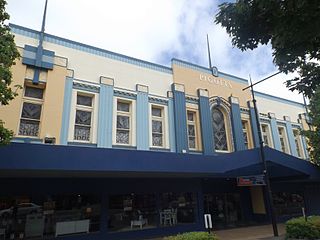
Pigott's Building is a heritage-listed commercial building and former department store at 381–391 Ruthven Street, Toowoomba, Queensland, Australia. It was designed by Toowoomba firm James Marks and Son, and built in 1910 as the principal store of the Pigott & Co. department store chain, replacing an earlier 1902 store on the site that had burned down in 1909. The store was extended in 1914, 1935, 1956, and again in the 1960s.

Exchange Hotel is a heritage-listed hotel at 134-138 Patrick Street, Laidley, Lockyer Valley Region, Queensland, Australia. It was designed by Eaton & Bates and built in 1902. It was added to the Queensland Heritage Register on 21 October 1992.
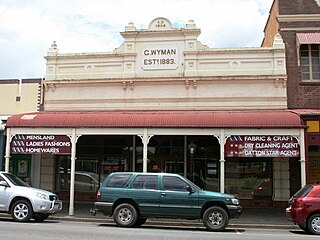
G Wyman Building is a heritage-listed shopping centre at 140–142 Patrick Street, Laidley, Lockyer Valley Region, Queensland, Australia. It was built in 1906. It was added to the Queensland Heritage Register on 21 October 1992.

Wiss Brothers Store is a heritage-listed shopping centre at 101 George Street, Kalbar, Queensland, Australia. It was built from 1890 to 1909. It was added to the Queensland Heritage Register on 29 October 1992. The building now houses The Emporium shopping experience, an extension of Empire Revival in Brisbane.

Corbett and Son Store is a heritage-listed store at 446–452 Brunswick Street, Fortitude Valley, City of Brisbane, Queensland, Australia. It was designed by Robin Dods and built in 1908. It was also known as Diamonds Dry Cleaners, Peerless Dry Cleaners and Isis Restaurant. It was added to the Queensland Heritage Register on 26 May 2000.

Taylor–Heaslop Building is a heritage-listed commercial building at 10–14 Logan Road, Woolloongabba, City of Brisbane, Queensland, Australia. It was designed by John Beauchamp Nicholson and built from 1889 to 1890. It is also known as Ernest Reid (draper), John Evan's Cash Draper, George Logan Draper, Johns & Co Draper, People's Cash Store (grocers), JR Blane, and Moreton Rubber Works. It was added to the Queensland Heritage Register on 6 February 2006.

Pollock's Shop House is a heritage-listed general store at 617–619 Stanley Street, Woolloongabba, City of Brisbane, Queensland, Australia. It was built c. 1865. It was added to the Queensland Heritage Register on 21 October 1992.

The Phoenix Buildings are heritage-listed commercial buildings at 647 Stanley Street, Woolloongabba, City of Brisbane, Queensland, Australia. They were designed by Richard Gailey and built from 1889 to 1890 by James Rix. They were added to the Queensland Heritage Register on 24 May 1995.

Empire Hotel is a heritage-listed hotel at 339 Brunswick Street, Fortitude Valley, City of Brisbane, Queensland, Australia. It was designed by Richard Gailey and built in 1888 by Smith and Ball. It was renovated in 1925 to a design by Richard Gailey, Junior. It was further renovated in 1937 to incorporate apartments designed by Hall and Phillips. It was added to the Queensland Heritage Register on 21 October 1992.

CSR Refinery is a heritage-listed former refinery at Lamington Street, New Farm, City of Brisbane, Queensland, Australia. It was built from 1892 to 1893. It is also known as Colonial Sugar Refining Company Refinery of New Farm. It was added to the Queensland Heritage Register on 21 October 1992.

Royal George Hotel and Ruddle's Building is a heritage-listed hotel at 323–335 Brunswick Street, Fortitude Valley, City of Brisbane, Queensland, Australia. It was built from c. 1850 to the 1960s. It is also known as Bush & Commercial Inn, Commercial Inn, Freemasons Arms, and Ruddle's Corner. It was added to the Queensland Heritage Register on 3 August 1998.

Garowie is a heritage-listed villa at 59 Whitehill Road, Eastern Heights, City of Ipswich, Queensland, Australia. It was designed by architect Samuel Shenton and built c. 1888 by Robert Wilson and Co. It was added to the Queensland Heritage Register on 21 October 1992.
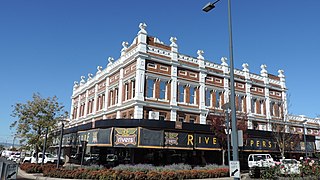
Barnes and Co. Trading Place is a heritage-listed former department store at 118 Palmerin Street, Warwick, Southern Downs Region, Queensland, Australia. It was designed by Wallace & Gibson and built from 1910 to 1911 by M Ivory. It is also known as Smith & Miller Furniture Store. It was added to the Queensland Heritage Register on 21 October 1992.

William Johnston's Shops are a heritage-listed row of three shops at 93 Brisbane Street, Ipswich, City of Ipswich, Queensland, Australia. They were built from 1877 to 1880s. It was added to the Queensland Heritage Register on 21 October 1992.
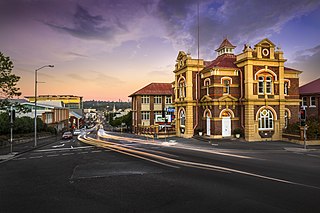
Queen Victoria Silver Jubilee Memorial Technical College is a heritage-listed technical college at 88 Limestone Street, Ipswich, City of Ipswich, Queensland, Australia. It was designed by architect George Brockwell Gill and built from 1897 to 1937. It is also known as Ipswich TAFE College and Ipswich Technical College. It was added to the Queensland Heritage Register on 21 October 1992.

Gooloowan is a heritage-listed villa at 43 Quarry Street, Ipswich, City of Ipswich, Queensland, Australia. It was designed by architect Charles Balding and built from c. 1864 onwards. It was added to the Queensland Heritage Register on 21 October 1992.
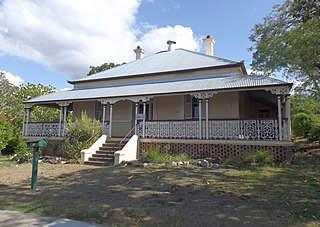
Keiraville is a heritage-listed detached house at 20 Roderick Street, Ipswich, City of Ipswich, Queensland, Australia. It was built c. 1880s. It was added to the Queensland Heritage Register on 9 July 1993.

Liberty Hall is a heritage-listed detached house at 84 Limestone Street, Ipswich, City of Ipswich, Queensland, Australia. It was built c. 1857. It is also known as Mary Tregear Hostel. It was added to the Queensland Heritage Register on 21 October 1992.


























